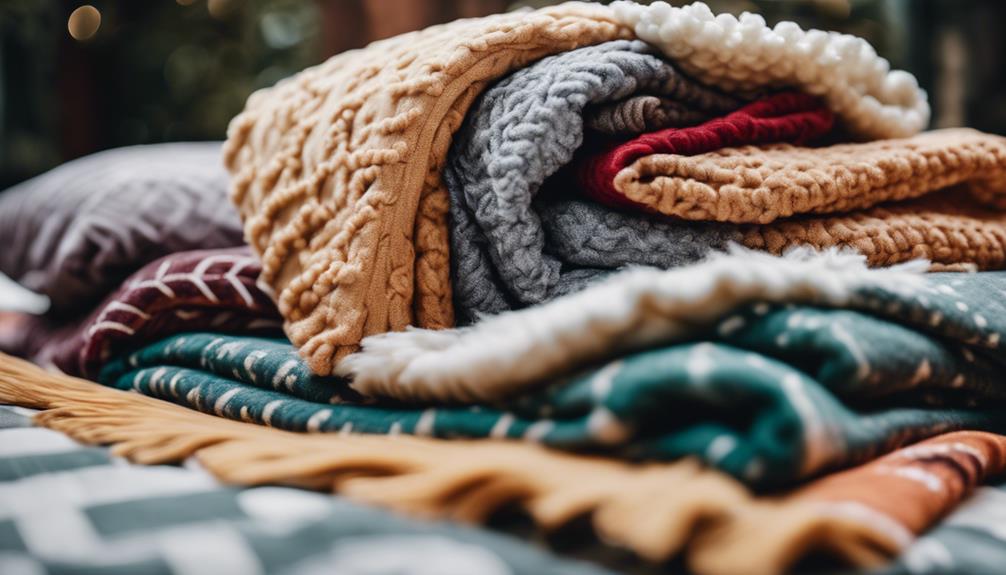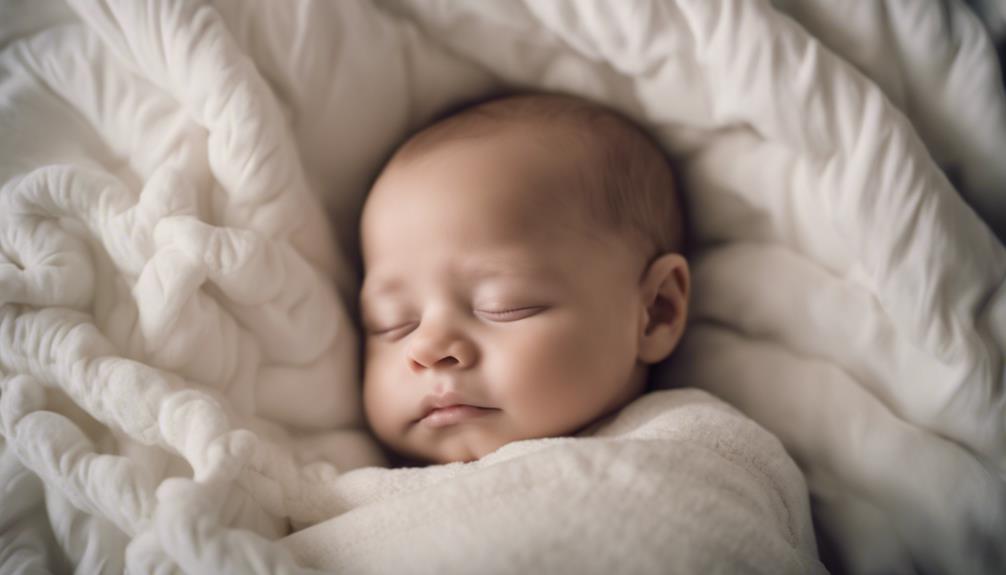When it’s time to say goodbye to your comforter, keep an eye out for signs such as thinning in the shoulder area and the absence of down clusters. These could suggest wear and decreased warmth. Comforters typically last between 8 to 15 years with proper care. Mold or musty odors indicate that it’s time for an immediate replacement due to health risks. Clumped feathers can also affect comfort and warmth, so be sure to shake or fluff them to avoid this issue. Consider donating old comforters to charity, using them for pet beds, or recycling them for a sustainable choice. Responsible disposal benefits both your space and the environment.
Key Takeaways
- Musty smell or visible mold indicate replacement is needed.
- Health risks from mold spores necessitate prompt disposal.
- Clumped feathers reduce comfort and warmth.
- Regularly inspect for wear and lack of down.
- Consider donating old comforters to charity for reuse.
Signs of Down Comforter Wear

When we inspect a down comforter for signs of wear, one key indicator is the lack of down in the shoulder area. Over time, the friction caused by movement can lead to the degradation of down clusters within the comforter. This degradation may progress to the point where some comforters have no down left at all, only layers of fabric. It's important to keep an eye out for these warning signs to determine if it's time to replace your down comforter.
To extend the lifespan of your down comforter, it's advisable to minimize direct pressure on it. Down comforters typically last between 8 to 15 years before showing signs of wear, but proper care and maintenance can help prolong their life. Regularly inspecting your comforter for lack of down in the shoulder area is a good practice to make sure that it continues to provide you with warmth and comfort for years to come.
Average Lifespan of a Comforter

Inspecting a comforter for signs of wear, such as clumped fill or loss of loft, can provide insight into its average lifespan, typically ranging from 8 to 15 years. The longevity of a comforter is influenced by various factors, including the quality of the materials, the level of care it receives, and how frequently it's used.
High-quality down comforters tend to have a longer lifespan compared to down alternative options. To guarantee your comforter lasts as long as possible, it's essential to practice proper care and maintenance. This includes using a duvet cover to protect the comforter from dirt and oils, as well as washing it regularly according to the manufacturer's instructions.
When to Replace Moldy Comforter

If you notice any signs of mold on your comforter, such as a musty smell or visible growth, it's important to replace it promptly.
Mold on a comforter can pose serious health risks, potentially causing respiratory issues and allergies.
Even washing a moldy comforter mightn't eliminate all the mold spores, so it's best to err on the side of caution and get a new one to guarantee a safe and healthy sleeping environment.
Moldy Comforter Signs
Noticing a musty odor in the bedroom or spotting visible mold on your comforter are clear signs that replacement may be necessary due to mold growth. Mold can trigger allergies and respiratory issues, making it important to act promptly.
Here are signs your comforter may be moldy:
- Musty odor lingering in the bedroom.
- Visible mold spots or discoloration on the comforter.
- Increased allergy symptoms when near the comforter.
- Dampness or moisture present in the comforter.
- Respiratory issues like coughing or sneezing worsen during sleep.
If you observe any of these indicators, replacing your comforter is advisable to prevent potential health risks associated with mold exposure.
Health Risks Involved
After detecting moldy signs on a comforter, immediate replacement is imperative to mitigate the health risks associated with exposure to mold spores. Moldy comforters can lead to respiratory issues due to inhaling mold spores, triggering allergies, asthma, and other respiratory conditions. Musty odors from a comforter indicate mold growth, necessitating prompt disposal. Regularly inspect your comforter for mold, especially after storage in damp environments. Below is a table highlighting the potential health risks of retaining a moldy comforter:
| Health Risks | Description |
|---|---|
| Respiratory Issues | Inhaling mold spores can lead to allergies and asthma. |
| Allergic Reactions | Mold exposure may trigger allergic reactions in sensitive individuals. |
| Compromised Immune System | Prolonged exposure to mold can weaken the immune system. |
| Skin Irritation | Contact with moldy comforters may cause skin irritation. |
| Respiratory Infections | Mold spores can increase the risk of respiratory infections. |
How to Recognize Clumped Feathers

Inspect your comforter by feeling for lumps or compacted areas that suggest clumped feathers, which can affect its comfort and warmth. Here are some tips to help you recognize clumped feathers:
- Check for Uneven Distribution: Run your hands over the comforter to identify areas where feathers have gathered, creating lumps or denser sections.
- Look for Hard Spots: Press down on different parts of the comforter to detect any hard spots that could indicate feather clumping.
- Notice Decreased Warmth: If certain areas of the comforter feel less insulated than others, it may be due to clumped feathers affecting the overall warmth.
Regularly Fluffing: To prevent feather clumping, regularly fluff and shake your comforter to ensure even distribution of feathers.
Maintain Comfort: Clumped feathers can lead to discomfort during use, so paying attention to these signs can help maintain the comfort and quality of your comforter.
Options for Disposing Old Comforters

When it comes to getting rid of old comforters, there are several environmentally-friendly alternatives worth exploring.
One option is to donate old comforters to homeless shelters or charity organizations to help those in need.
Another eco-friendly choice is to recycle old comforters by turning them into new items like pet beds or doormats, reducing waste.
Additionally, you can repurpose old comforters as covers for gardens or livestock during cold weather.
Prioritizing not simply discarding old comforters due to their environmental impact is crucial.
Instead, consider seeking out reputable organizations or secondhand markets that can properly dispose of or redistribute old comforters.
By being mindful of how you dispose of your comforters, you can help minimize waste and contribute to a more sustainable environment.
Where to Donate Used Bedding

Consider donating used bedding to various locations such as local orphanages, nursing homes, and charity organizations. Make sure to check which bedding items are acceptable for donation and follow the donation guidelines provided by the organization.
Donation Locations
Exploring various donation locations offers a meaningful way to pass on used bedding to those in need. Consider donating to local orphanages and nursing homes for direct contributions.
Explore charity organizations supporting remote areas or disaster shelters for bedding donations. Utilize secondhand markets to resell used bedding affordably.
Look for reputable organizations ensuring proper distribution of donated bedding. Making a positive impact by donating old bedding helps those in need and reduces waste.
Acceptable Bedding Items
To ensure our old comforters find new homes where they are needed most, we can donate them to local orphanages or nursing homes. When deciding on acceptable bedding items for donation, it's essential to take into account the needs of the recipients. Below is a table outlining some suitable bedding items that can be donated:
| Acceptable Bedding Items | Description | Examples |
|---|---|---|
| Comforters | Thick, quilted blankets | Down comforter, synthetic comforter |
| Duvets | Soft, flat bag filled with down or synthetic fibers | Duvet insert, duvet cover |
| Blankets | Single-layer covers for warmth | Fleece blanket, wool blanket |
Donation Guidelines
Donating used bedding to local orphanages and nursing homes can make a meaningful difference in the lives of those in need. When considering donation guidelines, keep in mind these bedding tips:
- Explore Charity Organizations: Look for groups supporting remote areas or disaster shelters for impactful donations.
- Utilize Secondhand Markets: Resell used bedding to individuals seeking affordable options.
- Verify Reputable Organizations: Confirm proper distribution of donated bedding items.
- Make a Positive Impact: Donate old bedding to those who can benefit from it.
Frequently Asked Questions
How Long Should You Keep a Comforter?
We should keep a comforter for about 8 to 15 years before replacing it. Factors such as quality, care, and frequency of use influence its lifespan. Signs of wear, like flattened areas lacking down clusters, indicate replacement may be necessary.
To prolong its life, avoid laying directly on the comforter. Stuffing it properly into a duvet cover can help maintain its condition. These practices can maximize the comforter's longevity.
When to Remove a Comforter?
When deciding on comforter removal, it's important to take into account wear signs like clumped feathers or color changes. A yellowed appearance or moldy smell may signal replacement. Age suitability varies; some kids prefer them longer.
Moving away gradually can foster independence. Focus on the child's comfort, not societal norms. Remember, it's about individual needs and emotional well-being.
What to Do With an Old Comforter?
When deciding what to do with an old comforter, options like donating to shelters, recycling for new items, repurposing for household needs, or reselling in secondhand markets can be beneficial.
By choosing these alternatives instead of discarding, we can help those in need, reduce waste, and contribute to sustainability efforts.
Remember to dispose of old comforters responsibly through reputable organizations or recycling centers to support waste reduction initiatives.
What Season Are Comforters Used In?
Comforters are used in colder seasons like fall and winter to provide warmth during sleep. They come in different warmth levels for varying temperatures. Lightweight ones are great for summer, while medium or heavyweight options are best for colder seasons.
Pairing them with duvet covers enhances both aesthetics and functionality. Selecting the right comforter based on seasonal needs guarantees a comfortable sleep experience year-round.
How Long Should I Keep a Comforter Before Getting Rid of It?
When it comes to reusing old comforters for sustainability, the ideal lifespan for a comforter depends on its condition and usage. Typically, a well-maintained comforter can last for 10-15 years. However, if it starts losing its fluffiness or develops stains that cannot be removed, it may be time to replace it.
Conclusion
To sum up, knowing when to get rid of your comforter is essential for maintaining a comfortable and healthy sleeping environment. By recognizing signs of wear, mold, and clumped feathers, you can determine when it's time to replace your bedding.
Remember, a good night's sleep starts with a quality comforter. As the saying goes, 'Out with the old, in with the new.' So, keep an eye on your comforter's condition and make the necessary changes for a restful night's sleep.










